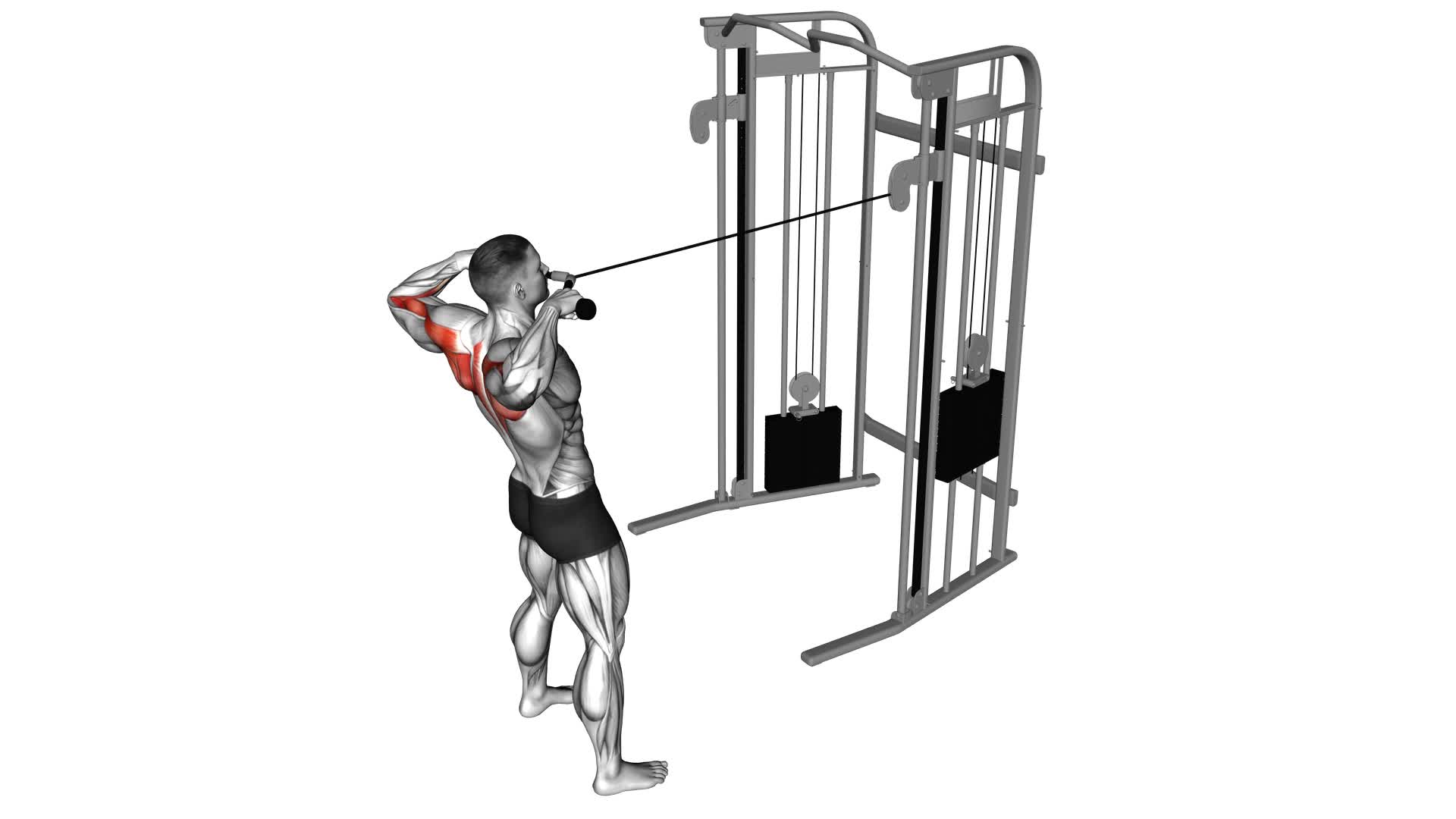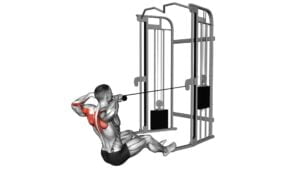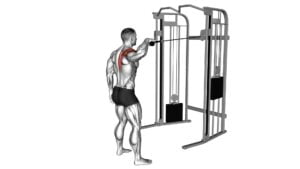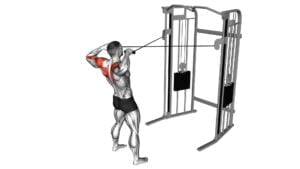Cable Standing Face Pull (With Rope) – Video Exercise Guide & Tips

In this video exercise guide, you'll learn how to perform the cable standing face pull with a rope for maximum effectiveness. By targeting your upper back and shoulder muscles, this exercise helps improve posture and upper body strength.
Watch This Exercise Video
Set up the cable machine and grab the rope, then follow the step-by-step instructions to ensure proper form.
With these expert tips and variations, you'll be able to add this exercise to your routine and see results in no time.
Key Takeaways
- Proper form and setup are essential for the Cable Standing Face Pull exercise.
- The exercise targets muscles such as the rear deltoids, rhomboids, trapezius, and rotator cuff.
- Improved muscle activation, better posture, and reduced risk of upper body injuries are some benefits of this exercise.
- Variations and modifications can be made to target different muscle groups and add variety to the workout routine.
Proper Form and Setup
To execute the Cable Standing Face Pull exercise with proper form and setup, begin by attaching a rope to a cable pulley machine. Make sure the pulley is set at chest height. Stand facing the machine with your feet shoulder-width apart and knees slightly bent. Grab the rope with an overhand grip, palms facing each other. Keep your core engaged and maintain a neutral spine throughout the exercise.
One common mistake is using too much weight, which can compromise your form and lead to injury. Start with a lighter weight and gradually increase as you become comfortable with the movement. Another mistake is pulling the rope too close to your face. Instead, focus on pulling towards your upper chest, keeping your elbows high and wide.
The Cable Standing Face Pull offers several benefits and advantages. It primarily targets the muscles in your upper back, including the rear deltoids, rhomboids, and traps. This exercise helps improve posture by strengthening the muscles that support the spine. It also helps to correct muscle imbalances, as it targets the muscles that are often neglected in our daily activities. Additionally, the Cable Standing Face Pull can enhance shoulder stability and mobility, reducing the risk of shoulder injuries.
Targeted Muscles
Engage your upper back muscles with the Cable Standing Face Pull exercise. This exercise targets multiple muscles in your upper body, providing a wide range of benefits for your overall strength and posture.
Here's how the Cable Standing Face Pull can activate and benefit your muscles:
- Rear Deltoids: The primary muscle activated in this exercise is the rear deltoid, which is located at the back of your shoulder. By targeting this muscle, you can improve shoulder stability and reduce the risk of imbalances or injuries.
- Rhomboids: The rhomboids are muscles located between your shoulder blades. The Cable Standing Face Pull strengthens these muscles, helping to improve your posture and overall upper back strength.
- Trapezius: The traps are large muscles that extend from the base of your skull to the middle of your back. This exercise activates the upper and middle fibers of the trapezius, contributing to improved shoulder mobility and stability.
- Rotator Cuff: The Cable Standing Face Pull also engages the rotator cuff muscles, which are responsible for shoulder rotation and stability. Strengthening these muscles can help prevent shoulder injuries and improve overall shoulder function.
Engaging these muscles through the Cable Standing Face Pull exercise can lead to improved muscle activation, better posture, and reduced risk of upper body injuries.
Incorporating this exercise into your workout routine can provide a variety of exercise benefits and contribute to your overall upper body strength and stability.
Step-by-Step Instructions
Start by attaching a rope to the cable machine at chest height. Stand facing the machine with your feet shoulder-width apart and grab the rope handles with an overhand grip. Keep your back straight and engage your core. Pull the rope towards your face by retracting your shoulder blades and squeezing your upper back muscles. Keep your elbows high and out to the sides, and focus on pulling with your rear delts. Slowly return to the starting position and repeat for the desired number of reps.
When performing the cable standing face pull, it's important to avoid common mistakes. One common mistake is using too much weight, which can lead to poor form and strain on the shoulders. Start with a lighter weight and gradually increase as you become more comfortable and confident with the exercise. Another mistake is pulling the rope too far back, which can put excessive stress on the shoulder joints. Instead, focus on pulling the rope towards your face while maintaining proper form and control.
Incorporating cable standing face pull into your workout routine can provide several benefits. This exercise targets the muscles of the upper back, including the rear delts, rhomboids, and traps. It helps improve posture by strengthening the muscles responsible for pulling the shoulders back and down. Additionally, the cable standing face pull can enhance shoulder stability and reduce the risk of injuries, especially for those who participate in sports or activities that require overhead movements.
Tips for Maximum Effectiveness
For maximum effectiveness of the cable standing face pull, focus on maintaining proper form and control throughout the exercise. This will ensure that you're targeting the correct muscles and minimizing the risk of injury.
Here are some tips to help you get the most out of this exercise:
- Use the appropriate equipment: To perform the cable standing face pull, you'll need a cable machine with a rope attachment. Make sure the machine is set at an appropriate height for your height and that the rope is securely attached.
- Start with a light weight: It's important to start with a weight that you can comfortably handle. This will allow you to focus on proper form and control before increasing the resistance.
- Keep your shoulders down: One common mistake is allowing the shoulders to shrug up towards the ears during the movement. Keep your shoulders down and away from your ears throughout the exercise.
- Squeeze your shoulder blades: At the end of the movement, focus on squeezing your shoulder blades together. This will help activate the muscles in your upper back and improve posture.
Modifications and Variations
To modify or vary the cable standing face pull exercise, you can incorporate different equipment or adjust the positioning of your body. These exercise modifications and alternative variations can help you target different muscle groups and add variety to your workout routine.
One way to modify the cable standing face pull is to use different equipment. Instead of using a rope attachment, you can use a straight bar or a V-bar attachment. This will change the grip and hand positioning, putting more emphasis on different muscles in your upper back and shoulders.
Another option is to use resistance bands instead of a cable machine. This can provide a different type of resistance and challenge your muscles in a new way.
Adjusting the positioning of your body can also modify the exercise. Instead of standing, you can try performing the face pull in a kneeling or seated position. This can change the angles and leverage of the movement, targeting different muscles and adding variety to your routine.
Frequently Asked Questions
How Many Sets and Reps Should I Do for the Cable Standing Face Pull Exercise?
To determine the sets and reps for the cable standing face pull exercise, consider your fitness goals and current fitness level. Generally, it's recommended to perform 3-4 sets of 10-15 reps.
However, if you're a beginner, you may start with fewer sets and reps and gradually increase as you get stronger. Remember to maintain proper form and engage your muscles throughout the exercise.
For more tips on maximizing the effectiveness of this exercise, continue reading the Cable Standing Face Pull (With Rope) – Video Exercise Guide & Tips {565612}.
Can I Use a Resistance Band Instead of a Cable Machine for This Exercise?
Yes, you can use a resistance band as an alternative to a cable machine for the standing face pull exercise. However, using a cable machine has its benefits.
The cable machine provides a constant tension throughout the movement, allowing for better muscle activation and control. Additionally, the cable machine typically offers more resistance options to challenge your muscles.
Nevertheless, if a cable machine isn't available, a resistance band can still be effective in targeting your rear deltoids and upper back muscles.
What Is the Recommended Weight or Resistance Level for Beginners?
For beginners, the recommended weight or resistance level for the cable standing face pull can vary. It's important to start with a lighter weight to focus on proper form and technique. Begin with a weight that allows you to perform the exercise with control and without straining.
Gradually increase the weight as you become more comfortable and confident. Remember to maintain proper posture, engage your back and shoulder muscles, and pull the rope towards your face while keeping your elbows high.
Are There Any Common Mistakes to Avoid While Performing the Cable Standing Face Pull?
When performing the cable standing face pull, it's important to be aware of common mistakes to avoid. Maintain proper form and technique throughout the exercise to maximize its effectiveness and minimize the risk of injury.
Avoid using excessive weight or resistance that could lead to compromised form. Keep your shoulders relaxed and focus on engaging your upper back muscles.
Remember to always consult with a fitness professional for personalized guidance and support.
Can I Incorporate This Exercise Into My Shoulder or Upper Body Workout Routine?
Yes, you can definitely incorporate the cable standing face pull into your shoulder or upper body workout routine. This exercise is great for targeting your rear delts, upper back, and rotator cuff muscles.
By performing different variations of the cable standing face pull, you can target specific muscles even more. For example, you can use different grips or adjust the height of the cables to work different areas.
Adding this exercise to your routine will help improve your overall upper body strength and posture.
Conclusion
In conclusion, the cable standing face pull with rope is a highly effective exercise for targeting and strengthening the muscles of the upper back and shoulders. By using proper form and following the step-by-step instructions, you can maximize the effectiveness of this exercise.
Additionally, there are various modifications and variations that can be incorporated to continue challenging your muscles and prevent plateaus.
Incorporate this exercise into your routine to improve your posture and overall upper body strength.

Author
Years ago, the spark of my life’s passion ignited in my mind the moment I stepped into the local gym for the first time. The inaugural bead of perspiration, the initial endeavor, the very first surge of endorphins, and a sense of pride that washed over me post-workout marked the beginning of my deep-seated interest in strength sports, fitness, and sports nutrition. This very curiosity blossomed rapidly into a profound fascination, propelling me to earn a Master’s degree in Physical Education from the Academy of Physical Education in Krakow, followed by a Sports Manager diploma from the Jagiellonian University. My journey of growth led me to gain more specialized qualifications, such as being a certified personal trainer with a focus on sports dietetics, a lifeguard, and an instructor for wellness and corrective gymnastics. Theoretical knowledge paired seamlessly with practical experience, reinforcing my belief that the transformation of individuals under my guidance was also a reflection of my personal growth. This belief holds true even today. Each day, I strive to push the boundaries and explore new realms. These realms gently elevate me to greater heights. The unique combination of passion for my field and the continuous quest for growth fuels my drive to break new ground.







